Journal of
eISSN: 2373-6410


Case Report Volume 11 Issue 5
1Department of neurology, Mohamed V Military Teaching Hospital, Mohamed V University, Rabat, Morocco
2Department of neurophysiology, Mohamed V Military Teaching Hospital, Mohamed V University, Rabat, Morocco
Correspondence: Mohamed Hamid, Department of Neurology, Mohamed V Military Teaching Hospital, Mohamed V University, Rabat, Morocco, Tel +212 6 66 97 00 78
Received: July 30, 2021 | Published: September 9, 2021
Citation: Hamid M, Benmoh Y, Adan K, et al. Isolated abducens nucleus syndrome due to pontine tegmentum infarction. J Neurol Stroke. 2021;11(5):135-137. DOI: 10.15406/jnsk.2021.11.00472
Introduction: Abnormalities of horizontal gaze could be caused by damage of the abducens nucleus due to ischemic lesion. We report a patient with isolated horizontal gaze palsy as a result of a small ischemic lesion of the pontine tegmentum.
Observation: A 61-year-old man, with medical history of diabetes mellitus, dyslipidemia and high blood pressure, was hospitalized after 12 hours of transient dizziness and diplopia. On examination, he had conjugate eye deviation to the right side with horizontal gaze paralysis toward controlateral side. Vertical eye movements, convergence and pupillary reflex were preserved with no peripheral facial palsy. Brain MRI revealed a small lesion in the left pontine tegmentum. Patient received aspirin with atorvastatin and the gaze palsy has been disappeared three weeks later.
Discussion: Conjugate lateral eye movement paralysis is commonly attributed to lesions of the caudal pons involving the abducens nucleus. horizontal gaze palsy is often associated to an ipsilateral peripheral facial palsy. In our case, the left lateral gaze palsy was isolated. The pontine lesion should be strictly confined the abducens nucleus which is extremely rare. the outcome of eye movement deviation in brainstem lesions is favorable within few weeks.
Conclusion: Our case provides evidence that small pontine lesions can damage the abducens nerve nucleus without causing ipsilateral peripheral facial palsy.
Keywords: abducens nucleus syndrome, pontine tegmentum infarction, horizontal gaze palsy
Conjugate gaze palsy associated to stroke was first described by Prevot in 1865.1 Disturbances of horizontal gaze are commonly related to ischemic lesions of the caudal pons, with involvement of motor, cerebellar, sensory and cranial nerve dysfunction.2 Lesions limited to the region of the abducens nucleus are rare, cause ipsilateral gaze palsy typically associated with ipsilateral peripheral facial palsy.3,4
We report a case of isolated horizontal gaze palsy due to a small pontine tegmentum infarction involving the abducens nucleus.
A 61-year-old man, was admitted 12 hours after sudden transient dizziness, nausea and diplopia. He had a medical history of diabetes mellitus, high blood pressure and dyslipidemia. Examination revealed conscious apyretic patient with supple neck. Neurologic examination showed right eye conjugate deviation with conjugate gaze palsy toward the left side. Horizontal saccades, pursuit movements and oculocephalic movement were absent. Vertical eye movements (saccades and pursuit) and convergence were normal (Figure 1).

Figure 1 Eye movements to the right (A,B,C) Eye movements to the left (D,E,F) Primary gaze position (G,H,I).
Pupillary reflex was normal and there was no peripheral facial palsy or other cranial nerve involvement. A leftward gait deviation was observed. Cerebral MRI showed increased signal intensity in DWI, Flair and T2 sequences restricted to the left dorsomedial pontine tegmentum referring to vascular lesion (Figure 2). Paraclinical tests conclude to stroke secondary to atherosclerosis. The patient was treated with aspirin and atorvastatin. Eight days after starting treatment, the conjugate eye deviation disappeared. Three weeks after the onset of symptoms, the horizontal gaze palsy has been resolved (Figure 3).
The nucleus abducens represents the final common pathway of horizontal eye movements, with 2 populations of neurons: motor neurons and interneurons.5,6 The motor neuron innervates ipsilateral rectus muscle, while interneuron, after crossing the midline is connected to the controlateral nucleus of the medial rectus muscle via the medial longitudinal fasciculus. Lesion of the 6th nucleus causes paralysis of adduction of controlateral eye and of abduction of ipsilateral eye, which is ipsilateral gaze palsy.7 Isolated abducens nucleus syndrome is extremely rare, for that the lesion must be limited to the nucleus area without extending to the surrounding structures. Absence of unidirectional horizontal gaze for saccades, vestibulo-ocular reflexes, and pursuit localizes a lesion to the ipsilateral abducens nucleus.
The course of this case and the neuroradiological findings suggest that the left abducens nucleus is involved. Our patient presented with a small infarction of the left dorsomedial pontine tegmentum which was revealed by dizziness and transient diplopia with isolated conjugate gaze paralysis to the left side. The peculiarity of our case is the absence of ipsilateral peripheral facial palsy, as this cranial nerve is looping around the abducens nucleus.3,5
Caudal paramedian pontine reticular formation (PPRF) represents the premotor structure for horizontal saccades, which can be involved in ipsilateral gaze palsy with absence of ipsilateral saccades and preservation of pursuit and vestibulo-ocular reflexes.6
In our case, complete absence of pursuit and oculo-vestibular reflexes supports the hypothesis of abducens nucleus involvement. Cerebral MRI showed infarct limited to the area of the abducens nucleus on the wall of the 4th ventricle. The PPRF is located more anteriorly and superiorly from the nucleus, and seems to be spared by the infarct. Few cases have been reported over the literature, including infarct, multiple sclerosis, histiocytosis X, Wernicke-Korsakoff syndrome and tumors.5,7–9
Patients with conjugate eye deviation due to brainstem lesion showed a favorable outcome, with horizontal gaze palsy resolved within few days to three weeks.10 Our patient has been recovered after three weeks of the onset of symptomatology.
We learn from this case that conjugate eye deviation without ipsilateral facial palsy is possible. Its clinical presentation includes: conjugate gaze palsy toward the ipsilateral side without horizontal saccades, pursuit or oculocephalic movements.
None.
The authors declare having no conflict of interest.

©2021 Hamid, et al. This is an open access article distributed under the terms of the, which permits unrestricted use, distribution, and build upon your work non-commercially.